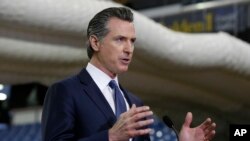California classrooms could reopen with modifications as soon as late July, California Gov. Gavin Newsom said Tuesday, bringing a new wave of anxiety for parents, teachers and students.
Newsom laid out the possible change, the earliest proposed start date yet, as part of a reopening plan that would allow retailers and manufacturers to restart likely within weeks. Child care and summer schools along with parks, trails and other outdoor spaces may also be allowed to reopen.
No decisions have been made about an early school start, Newsom said, noting that the "learning loss is very real." Almost all schools are closed under California's statewide stay-at-home order, and educators and students have been struggling to adapt to at-home learning.
The state also doesn't have the power to order districts to reopen; changes will need to be worked out between local districts and teachers unions. Tuesday's announcement appeared to catch California's top schools official by surprise, who said in a statement that "we all heard for the first time today the idea of schools reopening as early as July or August."
Superintendent of Public Instruction Tony Thurmond said "some major questions" still need to be answered. "First and foremost: Can this be done in a way that protects the health and safety of our students, teachers, and school staff?
At the same time California educators grapple with how to reopen, the state's more than 1,000 school districts are expected to face budget cuts as tax revenue tumbles due to job losses and business closures.
State Board of Education President Linda Darling-Hammond told lawmakers Tuesday that schools need $100 million to purchase 400,000 computers and 290,000 internet hotspots to help "close the divide and maintain access for students." She said most of California's 6.2 million students do have access to technology.
A lot of questions remain about the timeline and structure for schools that reopen, decisions that will be made district-by-district. Many districts already start the school year in August.
Whatever the timeline, school will likely look radically different, officials say.
Among the scenarios Newsom has previously raised: staggered start times to limit the number of students in a school at one time; changes to recess, lunch and other group gatherings; and a hybrid of classroom and online learning.
One idea would be to keep students with their previous year's teachers, even temporarily, said Darling-Hammond.
"Teachers can teach more effectively when they know their students well and students learn more effectively in an environment of trust and belonging," she said. She said some experts have said it could last for a quarter "before passing students on to the next grade level teacher."
It also isn't clear if an earlier start will mean a longer school year or a school year that ends sooner than usual. California Federation of Teachers President Jeff Freitas said it's possible the time could be made up if schools need to close again for a break in fall or winter because of a second surge of coronavirus.
The schools announcement was part of a four-phase plan Newsom discussed Tuesday to gradually reopen the state when hospitalization rates due to coronavirus begin to stabilize. California remains focused for now on obtaining more protective gear for essential workers and increasing testing and tracing of the virus.
Unlike some other states that are already allowing hair and nail salons to operate, those would have to wait until a later phase of California's reopening plan, said Sonia Angell, the state public health director. And concerts and sporting events are even further away, possibly not until there's a virus treatment.
It wasn't clear when restaurants may be able to reopen for dine-in services. Many have begun offering takeout and delivery since Newsom issued his statewide stay-at-home order March 19, but thousands of restaurant workers have lost their jobs.
As the state considers reopening, Newsom is juggling a state with a split personality. Officials in some rural counties say they're ready to reopen while urban centers are wary.
Officials from six rural Northern California counties — Sutter, Yuba, Butte, Colusa, Tehama and Glenn — wrote to Newsom Monday asking to implement "a careful and phased reopening of our local economies." The counties, with a population of about 500,000, have seen fewer than 100 confirmed COVID-19 cases and only a handful of deaths. Rural areas elsewhere in the U.S. are similarly reopening.
For now, Newsom said local governments can only adopt stricter, not looser, measures than the state's plan. Without addressing those six counties directly, he pushed back on a quick reopening, saying it can't be done without better tracking and tracing capabilities.
Sutter County Supervisor Mike Ziegenmeyer, who is vice president of a specialized equipment manufacturer, is among those clamoring for shops and restaurants to reopen sooner.
"Our tolerance levels are going down, they're not going up," said Ziegenmeyer, who attended a news conference outside the Capitol Tuesday urging greater flexibility.
For most people, the virus causes mild or moderate symptoms, such as fever and cough that clear up in two to three weeks. For some, especially older adults and people with existing health problems, it can cause more severe illness and death.





